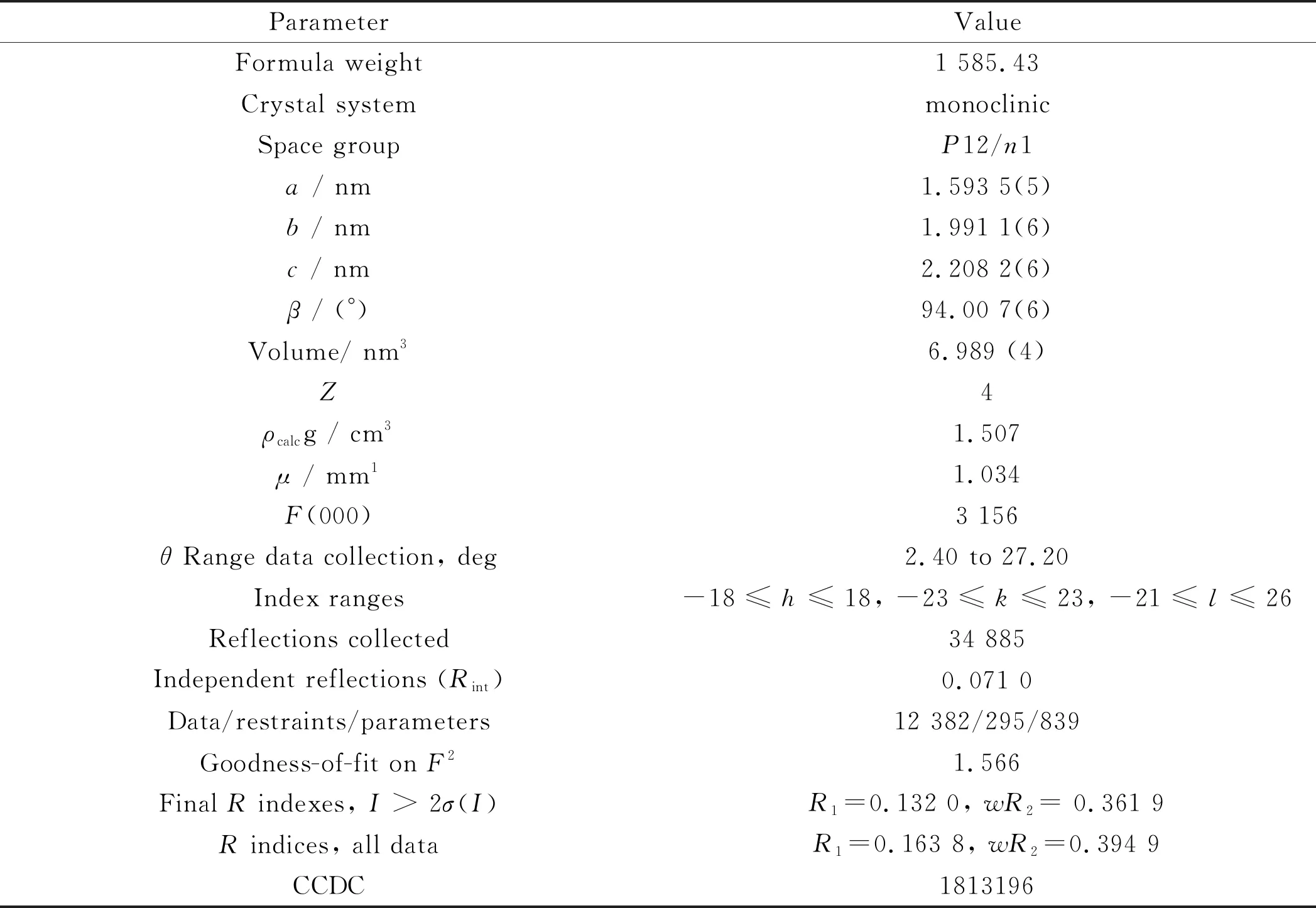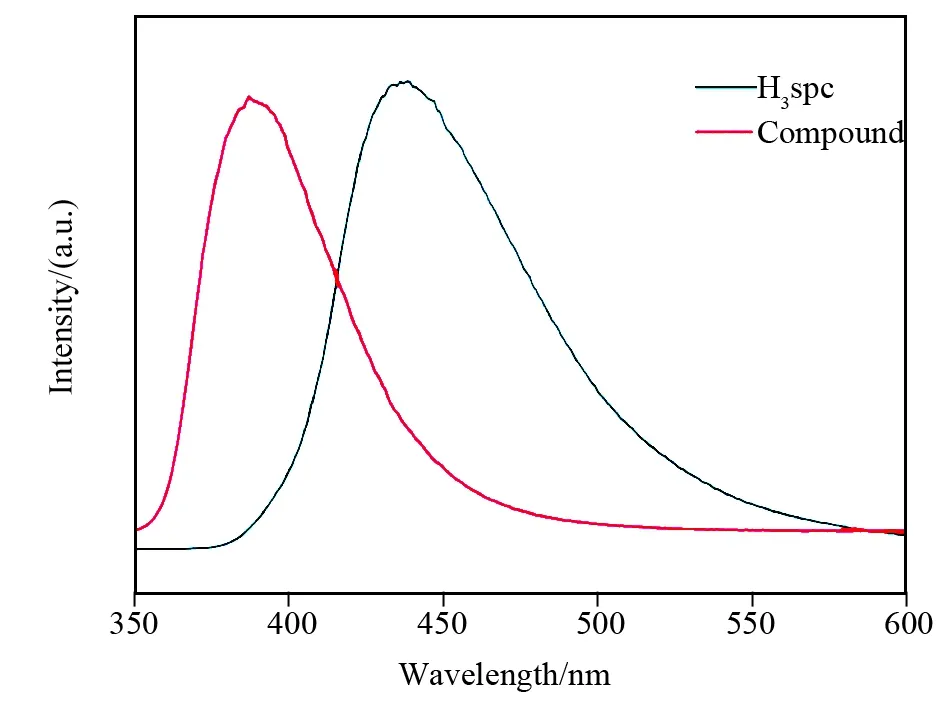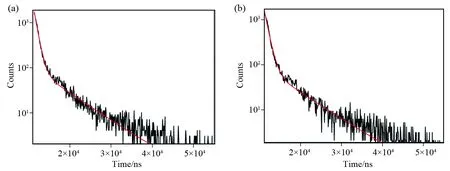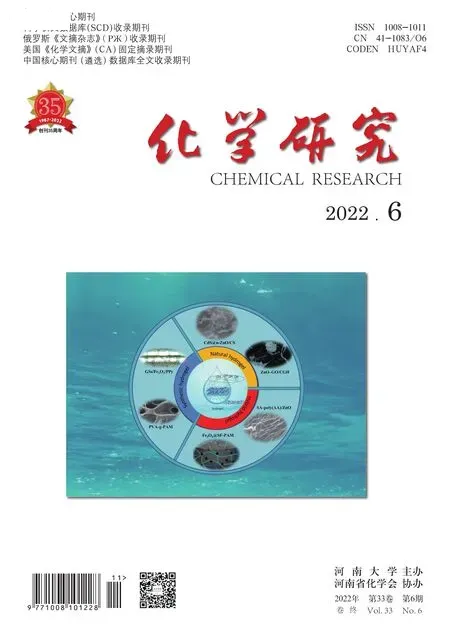基于4-((5-磺基喹啉-8-基)氧)邻苯二甲酸的镉-金属有机骨架的合成、结构和荧光性质
张 武
(河南大学 化学化工学院,河南 开封 475004)
Owing to their kaleidoscopic structure and potential applications, metal-organic frameworks (MOFs) have been the focus of researchers in recent decades[1-7]. As porous inorganic-organic hybrid materials, MOFs make a significant contribution in many highlighted areas, such as (homogeneous/heterogeneous) catalysis, gas storage and separation, chemical sensing, drug delivery, molecular magnetics, electrical properties have been reported in related literatures[8-14]. Generally, the nature of the MOFs usually depends on the structure, and the diversity of the structure is closely related to the geometry of ligands and the choice of metal ions, which in turn affect the overall chemical functions of the MOFs[15-16]. Among the ligands used in constructing the frameworks, polycarboxylic acid ligands are most commonly used due to their different advantages of rigid or flexible structures. From its structural point of view, flexible ligands can change their geometry to meet metal ion coordination requirements and build multiple topologies, in contrast, rigid ligands are easy to construct stable pore structures[17-20]. Simultaneously, auxiliary N-ligands containing pyridine or imidazole rings are more likely to form hydrogen bonds, π…π stacking, C-H…π interactions, thereby in favour of expanding the structural configuration of the coordination polymers[21-23]. In addition, d10metal ions not only have different coordination numbers and coordination configurations, but also the electronic transfer between metal centers and organic ligands, demonstrating that Cd(II) MOFs are usually good candidates as luminescent materials[24-25].
Inspired by the points mentioned above, we selected 4-((5-sulfoquinolin-8-yl)oxy)phthalic acid (H3spc), auxiliary ligand 1,4-bis(imidazol-1-ylmethyl)benzene (bitb) together with cadmium salt hydrothermal to synthesis a novel coordination polymer, namely, [Cd3(spc)2(bitb)2]n. The single crystal X-ray diffraction indicates that it has a 3D framework formed by mixed ligands thought π…π weak forces between the adjacent chains. In addition, the luminescence properities of coordination polymer were also performed.
1 Experimental section
1.1 Material and measurements
All the chemicals are of analytical grade and commercially purchased (H3spc and bitb ligands are from the Jinan Camolai Trading Company, other reagents are from the Tianjin Chemical Reagent Factory) and used without further purification. The IR spectra were recorded on AVATAR 360 FT-IR spectrometer (KBr pellets were used) in the range of 4 000-400 cm-1. Elemental analyses (C, H, and N) were measured using a Perkin-Elmer 240 CHN Elemental Analyzer. Crystallographic data were determined with a Bruker Smart CCD X-ray single-crystal diffractometer. Elemental analyses (C, H, and N) were measured by a Perkin-Elmer 240 CHN Elemental Analyzer. Powder X-ray diffraction (PXRD) data were recorded on a Bruker D8 Advance instrument using Cu-Kαradiation (λ= 0.154 056 nm) in the range of 2θ= 5°-50° at room temperature. Thermogravimetric analysis was measured on a Perkin-Elmer TGA7 instrument with a heating rate of 10 ℃/min from ambient temperature to 1 000 ℃ in N2flow. Fluorescence spectrum and lifetime were performed on an Edinburgh FLS 980 analytical instrument equipped with 450 W xenon lamp and UF900H high-energy microsecond flashlamp as the excitation source.
1.2 Synthesis of [Cd3(spc)2(bitb)2]n
A mixture of H3spc (19.5 mg, 0.05 mmol), bitb (11.9 mg, 0.05 mmol) and Cd(ClO4)2(64.4 mg, 0.15 mmol), 8 mL H2O and five drops of NaOH (1 mol/L) was stirred for 30 min at room temperature. Then the resulting solution was transferred into 25 mL Teflon-lined stainless steel vessel and heated at 140 ℃ for 3 days. After cooling to room temperature, and yellow block crystals of compound were obtained (yield: 26.49%, based on Cd). For C62H43Cd3N10O16S2Anal. calcd.,%: C, 46.97; H, 2.73; N, 8.83. Found,%: C, 46.96; H, 2.81; N, 8.92. IR (v,cm-1): 3 440 m, 1 582 s, 1 550 s, 1 512 m, 1 398 s, 1 304 m, 1 234 s, 1 208 s, 1 142 m, 1 090 m, 1 040 s, 936 w, 860 s, 698 s, 658 m, 616 w, 554 m, 482 m. The bands from 1 590 to 1 550 cm-1correspond to the COO-asymmetric symmetric stretching vibrations (νasCOO-) and the COO-symmetry stretching vibrations (νsCOO-) ranging from 1 400 to 1 370 cm-1.
1.3 Crystallographic data collection and refinement
Crystal data collections was performed on a Bruker Smart CCD X-ray single-crystal diffractometer with graphite monochromated Mo Kα-radiation (λ= 0.071 073 nm) at 298 K. Multi-scan empirical absorption corrections were applied to the data using the SADABS and independent reections were collected in a range of 2.40°-27.20° for coordination polymer. The crystal structure has been solved using Fourier synthesis and direct methods. Positional and thermal parameters have been rened by the full-matrix least-squares method onF2using the SHELXTL software package. The crystallographic data for coordination polymer are listed in Table 1. Selected bond lengths and bond angles are given in Table 2.

Table 1 Summary of crystallographic data for coordination polymer

Table 2 Selected bond lengths (nm) and bond angles (deg) for compound
2 Results and discussion
2.1 Description of crystal structures
The single crystal X-ray diffraction analysis suggests that the as-synthesized compound crystallizes in monoclinic with space group ofP12/n1. The asymmetric unit of coordination polymer contains of three crystallographically independent Cd(II) centers. Fig. 1a indicates that Cd1 is six-coordinated by four oxygen atoms (O1, O3, O9 and O11) from two H3spc ligands and two nitrogen atoms (N3 and N7) from two bitb auxiliary ligands, whereas Cd2 is also six-coordinated by four oxygen atoms (O4, O5, O9, and O10) from three H3spc moieties and two nitrogen atoms (N1 and N6) from two bitb linkers, and meanwhile Cd3 is seven-coordinated with five oxygen atoms (O1, O2, O11, O12 and O13) from three H3spc ligands and two nitrogen atoms (N2 and N10) from two bitb ligands. Both Cd1 and Cd2 give rise to distorted octahedral coordination geometries while Cd3 exhibits a distorted seven-coordinated single-capped-octahedral coordination configuration. Around the three Cd(II) centers, the H3spc ligand adopt two types of coordination modes (μ4-η1,η1,η1,η2,η1,η1andμ4-η1,η1,η1,η2,η1,η2, see Scheme 1). The bond lengths of Cd-O are in the range of 0.225 5(12)-0.282 3(14) nm and those of Cd-N are of 0.221 7(15)-0.227 7(16) nm, which are well-matched to those observed in the previously reported Cd(II) coordination polymers[26-28].

Scheme 1 Coordination modes of H3spc ligand in the coordination polymer

Fig.1 Structure of trinuclear Cd(II) units in compound (a); 1D chain based on carboxylic acid ligands (b); 2D sheet structure (c); 3D architecture with microporosities (d); Weak forces between the adjacent chains (e). (All of the hydrogen atoms are omitted for clarity)
It’s worth noting that three Cd(II) ions are bridged by three H3spc ligands to form a {Cd3O10N6} trinuclear unit (with the corresponding distances of Cd1…Cd3 = 0.397 17(20) nm, Cd1…Cd2 = 0.408 39(20) nm, and Cd2…Cd3 = 0.583 02(23) nm), based on which to elongated to a 1D infinite wavy chain. The neighbouring and parallel 1D chains are further linked to construct a 2D sheet by bitb linkers through Cd-N covalent binds, as displayed in Fig. 1c. Subsequently, the 2D sheets (alongbcplane) are interconnected centroid-to-centroid through π…π interaction (C7-C8-C12-C13-C14-C15 and C7′-C8′-C12′-C13′-C14′-C15′,dcentroid= 0.369 4 nm, dihedral angle of two aromatic rings is 3.99°) between the partially overlapping aromatic rings in H3spc ligands to assemble into a 3D architecture with irregular microporosities (as shown in Fig. 1d and 1e).
2.2 PXRD and thermogravimetric analysis
PXRD measurements show that the peak intensity and position of the experimental mode are very consistent with the simulated peak intensity and position, indicating that the product of compound is pure single phase. Simultaneously, the thermal stability of the compound was also investigated by TGA. The TG curve shows a weight loss in the range of 30-377 ℃, referring to the release of one molecule of bitb ligand (obsd: 15.55%; calcd: 15.03%). Thermоgravimetric analyses indicate that the compound maintains high thermal stability up to 289 ℃. H ereafter, its framework collapses continuously with the removal of the other organic components[29], as depicted in Fig. 2.

Fig.2 Simulated and experimental powder XRD patterns (a); Thermogravimetric analyses of coordination polymer (b)
2.3 Luminescent properties
Given d10metal ions and aromatic organic ligands have high coordination affinity and hence the synthetic MOFs are promising candidates for luminescent materials, therefore, the luminescent properties of compound and H3spc ligand were investigated in solid state at room temperature[30-33]. Upon an excitation at 298 nm, the intense emission peak locates at 437 nm for H3spc ligand, which can be reasonably assigned as the intraligand charge transitions (such as π*-n or π*-π)[34-35], and the emission spectrum of the compound displays the emission band at 395 nm when excited at 297 nm. When compared to the free polycarboxylic acid ligand, the emission peak of the coordination polymer exhibits obvious blue-shift (Δ=42 nm), which may be tentatively ascribed to the disturbance caused by the coordination interaction of the delocalized π bonds in ligand with the coordination metal center[36-39].

Fig.3 Emission spectra of H3spc and compound in solid state at room temperature
Additionally, the luminescence lifetimes of H3spc and compound were explored at ambient temperature. The decay curves for organic ligands and coordination polymerare well fitted to double exponential function:I=A1exp (t/τ1) +A2exp (t/τ2), whereIis the luminescent intensities,τ1andτ2are defined as the luminescent lifetimes whileA1andA2refer to the pre-exponential factors. For compound:τ1= 0.91μs andτ2= 7.57μs (A1= 1 643.71,A2= 80.22,R2= 0.990) and free ligand H3spc:τ1= 0.79μs andτ2= 7.01μs (A1= 1 888.88,A2= 94.11,R2= 0.966), the slight increase of luminescence lifetimes of compoundcompared with ligand may be caused by the reduction of the nonradiative decay for the excited states of intraligand[40-41].

Fig.4 Luminescence decay curves of H3spc ligand (a) and compound (b)
3 Conclusions
In summary, adopted the mixed ligand strategy, and selected H3spc (4-((5-sulfoquinolin-8-yl)oxy)phthalic acid) and bitb (1,4-Bis(imidazol-1-ylmethyl)benzene) as ligands to form a novel Cd(II)-MOF with Cd(II) center. The 3D structure of Cd-MOF contains three crystal independent Cd(II) centers, and it is assembled by π…π interaction through the partially over-lapping aromatic rings in H3spc ligand. Furthermore, Cd-MOF maintains high thermodynamic stability up to 289 ℃. Luminescent properties indicate the maximum excitation and emission peaks of Cd-MOF are 297 nm and 395 nm, and the luminescent lifetimes areτ1= 0.90μs andτ2= 7.57μs (A1= 1 643.71,A2= 80.22,R2= 0.990), respectively.

